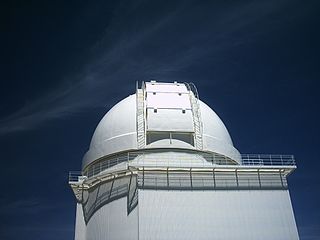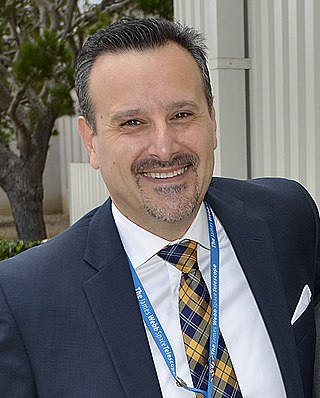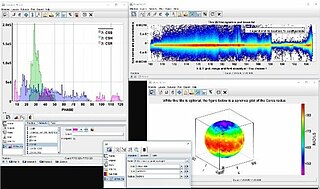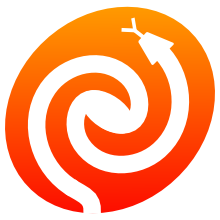
Astroinformatics is an interdisciplinary field of study involving the combination of astronomy, data science, machine learning, informatics, and information/communications technologies. [2] [3] The field is closely related to astrostatistics.

Astroinformatics is an interdisciplinary field of study involving the combination of astronomy, data science, machine learning, informatics, and information/communications technologies. [2] [3] The field is closely related to astrostatistics.
Astroinformatics is primarily focused on developing the tools, methods, and applications of computational science, data science, machine learning, and statistics for research and education in data-oriented astronomy. [2] Early efforts in this direction included data discovery, metadata standards development, data modeling, astronomical data dictionary development, data access, information retrieval, [4] data integration, and data mining [5] in the astronomical Virtual Observatory initiatives. [6] [7] [8] Further development of the field, along with astronomy community endorsement, was presented to the National Research Council (United States) in 2009 in the astroinformatics "state of the profession" position paper for the 2010 Astronomy and Astrophysics Decadal Survey. [9] That position paper provided the basis for the subsequent more detailed exposition of the field in the Informatics Journal paper Astroinformatics: Data-Oriented Astronomy Research and Education. [2]
Astroinformatics as a distinct field of research was inspired by work in the fields of Geoinformatics, Cheminformatics, Bioinformatics, and through the eScience work [10] of Jim Gray (computer scientist) at Microsoft Research, whose legacy was remembered and continued through the Jim Gray eScience Awards. [11]
Although the primary focus of astroinformatics is on the large worldwide distributed collection of digital astronomical databases, image archives, and research tools, the field recognizes the importance of legacy data sets as well—using modern technologies to preserve and analyze historical astronomical observations. Some Astroinformatics practitioners help to digitize historical and recent astronomical observations and images in a large database for efficient retrieval through web-based interfaces. [3] [12] Another aim is to help develop new methods and software for astronomers, as well as to help facilitate the process and analysis of the rapidly growing amount of data in the field of astronomy. [13]
Astroinformatics is described as the "fourth paradigm" of astronomical research. [14] There are many research areas involved with astroinformatics, such as data mining, machine learning, statistics, visualization, scientific data management, and semantic science. [7] Data mining and machine learning play significant roles in astroinformatics as a scientific research discipline due to their focus on "knowledge discovery from data" (KDD) and "learning from data". [15] [16]
The amount of data collected from astronomical sky surveys has grown from gigabytes to terabytes throughout the past decade and is predicted to grow in the next decade into hundreds of petabytes with the Large Synoptic Survey Telescope and into the exabytes with the Square Kilometre Array. [17] This plethora of new data both enables and challenges effective astronomical research. Therefore, new approaches are required. In part due to this, data-driven science is becoming a recognized academic discipline. Consequently, astronomy (and other scientific disciplines) are developing information-intensive and data-intensive sub-disciplines to an extent that these sub-disciplines are now becoming (or have already become) standalone research disciplines and full-fledged academic programs. While many institutes of education do not boast an astroinformatics program, such programs most likely will be developed in the near future.
Informatics has been recently defined as "the use of digital data, information, and related services for research and knowledge generation". However the usual, or commonly used definition is "informatics is the discipline of organizing, accessing, integrating, and mining data from multiple sources for discovery and decision support." Therefore, the discipline of astroinformatics includes many naturally-related specialties including data modeling, data organization, etc. It may also include transformation and normalization methods for data integration and information visualization, as well as knowledge extraction, indexing techniques, information retrieval and data mining methods. Classification schemes (e.g., taxonomies, ontologies, folksonomies, and/or collaborative tagging [18] ) plus Astrostatistics will also be heavily involved. Citizen science projects (such as Galaxy Zoo) also contribute highly valued novelty discovery, feature meta-tagging, and object characterization within large astronomy data sets. All of these specialties enable scientific discovery across varied massive data collections, collaborative research, and data re-use, in both research and learning environments.
In 2012, two position papers [19] [20] were presented to the Council of the American Astronomical Society that led to the establishment of formal working groups in astroinformatics and Astrostatistics for the profession of astronomy within the US and elsewhere. [21]
Astroinformatics provides a natural context for the integration of education and research. [22] The experience of research can now be implemented within the classroom to establish and grow data literacy through the easy re-use of data. [23] It also has many other uses, such as repurposing archival data for new projects, literature-data links, intelligent retrieval of information, and many others. [24]
| Year | Place | Link |
|---|---|---|
| 2021 | Caltech | |
| 2020 | Harvard | |
| 2019 | Caltech | |
| 2018 | Heidelberg, Germany | |
| 2017 | Cape Town, South Africa | |
| 2016 | Sorrento, Italy | |
| 2015 | Dubrovnik, Dalmatia | |
| 2014 | University of Chile | |
| 2013 | Australia Telescope National Facility, CSIRO | |
| 2012 | Microsoft Research | Archived 2018-10-22 at the Wayback Machine |
| 2011 | Sorrento, Italy | |
| 2010 | Caltech | Archived 2018-10-22 at the Wayback Machine |
Additional conferences and conference lists:

Astronomy is a natural science that studies celestial objects and the phenomena that occur in the cosmos. It uses mathematics, physics, and chemistry in order to explain their origin and their overall evolution. Objects of interest include planets, moons, stars, nebulae, galaxies, meteoroids, asteroids, and comets. Relevant phenomena include supernova explosions, gamma ray bursts, quasars, blazars, pulsars, and cosmic microwave background radiation. More generally, astronomy studies everything that originates beyond Earth's atmosphere. Cosmology is a branch of astronomy that studies the universe as a whole.

Institut de Radioastronomie Millimetrique (IRAM) is an international research institute and Europe's leading center for radio astronomy at millimeter wavelengths. Its mission is to explore the universe, study its origins and its evolution with two of the most advanced radio facilities in the world:

The Calar Alto Observatory is an astronomical observatory located in Almería province in Spain on Calar Alto, a 2,168-meter-high (7,113 ft) mountain in the Sierra de Los Filabres subrange of the Sierra Nevada.
Kenneth Irwin Kellermann is an American astronomer at the National Radio Astronomy Observatory. He is best known for his work on quasars. He won the Helen B. Warner Prize for Astronomy of the American Astronomical Society in 1971, and the Bruce Medal of the Astronomical Society of the Pacific in 2014.

Alberto Conti, is an astrophysicist and the Vice President and General Manager of the Civil Space Strategic Business Unit (SBU) at Ball Aerospace. He is one of the creators of the GoogleSky concept, of the idea of astronomical outreach at South by SouthWest 2013 and of the James Webb Space Telescope iBook. He is also the Executive Producer of the Emmy Winning CNN Films The Hunt for Planet B.

Somak Raychaudhury is an Indian astrophysicist. He is the Vice-Chancellor at Ashoka University and was the Director of the Inter-University Centre for Astronomy and Astrophysics (IUCAA), Pune. He is on leave from Presidency University, Kolkata, India, where he is a Professor of Physics, and is also affiliated to the University of Birmingham, United Kingdom. He is known for his work on stellar mass black holes and supermassive black holes. His significant contributions include those in the fields of gravitational lensing, galaxy dynamics and large-scale motions in the Universe, including the Great Attractor.

Ofer Lahav is Perren Chair of Astronomy at University College London (UCL), Vice-Dean (International) of the UCL Faculty of Mathematical and Physical Sciences (MAPS) and Co-Director of the STFC Centre for Doctoral Training in Data Intensive Science. His research area is Observational Cosmology, in particular probing Dark Matter and Dark Energy. His work involves Machine Learning for Big Data.
WASP-18 is a magnitude 9 star located 400 light-years away in the Phoenix constellation of the southern hemisphere. It has a mass of 1.29 solar masses.

The Astronomy and Astrophysics Decadal Survey is a review of astronomy and astrophysics literature produced approximately every ten years by the National Research Council of the National Academy of Sciences in the United States. The report surveys the current state of the field, identifies research priorities, and makes recommendations for the coming decade. The decadal survey represents the recommendations of the research community to governmental agencies on how to prioritize scientific funding within astronomy and astrophysics. The editing committee is informed by topical panels and subcommittees, dedicated conferences, and direct community input in the form of white papers summarizing the state of the art in each subdiscipline. The most recent report, Astro2020, was released in 2021.

A balloon-borne telescope is a type of airborne telescope, a sub-orbital astronomical telescope that is suspended below one or more stratospheric balloons, allowing it to be lifted above the lower, dense part of the Earth's atmosphere. This has the advantage of improving the resolution limit of the telescope at a much lower cost than for a space telescope. It also allows observation of frequency bands that are blocked by the atmosphere.
The Event Horizon Telescope (EHT) is a large telescope array consisting of a global network of radio telescopes. The EHT project combines data from several very-long-baseline interferometry (VLBI) stations around Earth, which form a combined array with an angular resolution sufficient to observe objects the size of a supermassive black hole's event horizon. The project's observational targets include the two black holes with the largest angular diameter as observed from Earth: the black hole at the center of the supergiant elliptical galaxy Messier 87, and Sagittarius A* at the center of the Milky Way.
Stanislav George Djorgovski is an American scientist and scholar. He obtained his B.A. in astrophysics in 1979 at the University of Belgrade. After receiving his PhD in astronomy from U.C. Berkeley in 1985, he was a Harvard Junior Fellow until 1987 when he joined the faculty at the California Institute of Technology, where he is currently a professor of astronomy and data science.

TOPCAT is an interactive graphical viewer and editor for tabular data. Although a general purpose tool capable of handling large and sparse datasets with correlation functionality its specialist application area is astronomy and it was initially designed to support virtual observatories. It is able to handle several digital file formats including FITS which is in common use in astronomy. The Acronym TOPCAT derives from Tool for OPerations on Catalogues And Tables.

Time-domain astronomy is the study of how astronomical objects change with time. Though the study may be said to begin with Galileo's Letters on Sunspots, the term now refers especially to variable objects beyond the Solar System. Changes over time may be due to movements or changes in the object itself. Common targets included are supernovae, pulsating stars, novas, flare stars, blazars and active galactic nuclei. Visible light time domain studies include OGLE, HAT-South, PanSTARRS, SkyMapper, ASAS, WASP, CRTS, GOTO and in a near future the LSST at the Vera C. Rubin Observatory.

Astropy is a collection of software packages written in the Python programming language and designed for use in astronomy. The software is a single, free, core package for astronomical utilities due to the increasingly widespread usage of Python by astronomers, and to foster interoperability between various extant Python astronomy packages. Astropy is included in several large Python distributions; it is part of package managers for Linux and macOS, the Anaconda Python Distribution, Enthought Canopy and Ureka.
Alice Eve Shapley is a professor at the University of California, Los Angeles (UCLA) in the Department of Physics and Astronomy. She was one of the discoverers of the spiral galaxy BX442. Through her time at University of California, Los Angeles (UCLA) she has taught Nature of the Universe, Black Holes and Cosmic Catastrophes, Cosmology: Our Changing Concepts of the Universe, Galaxies, Scientific Writing, AGNs, Galaxies, *and* Writing, and The Formation and Evolution of Galaxies and the IGM. Shapley has committed herself to over a two decades of research and publication in the interest of physics and astronomy.

Warrick John Couch is an Australian professional astronomer. He is currently a professor at Swinburne University of Technology in Melbourne. He was previously the Director of Australia's largest optical observatory, the Australian Astronomical Observatory (AAO). He was also the president of the Australian Institute of Physics (2015–2017), and a non-executive director on the Board of the Giant Magellan Telescope Organization. He was a founding non-executive director of Astronomy Australia Limited.

Amanda Elaine Bauer is an American professional astronomer and science communicator. She is the Deputy Director and Head of Science and Education at Yerkes Observatory in Williams Bay, Wisconsin. She was previously based in Tucson, Arizona, working as Head of Education and Public Outreach at the Large Synoptic Survey Telescope. From 2013 to 2016 she was a Research Astronomer at the Australian Astronomical Observatory (AAO). Her principal field of research concerns how galaxies form, how they create new stars, and particularly why they suddenly stop creating new stars.
Gopal Krishna is an Indian radio astronomer and a senior professor at the National Centre for Radio Astrophysics. Known for his studies on Radio galaxies and quasars, Krishna is an elected fellow of all the three major Indian science academies viz. Indian Academy of Sciences, National Academy of Sciences, India and Indian National Science Academy. The Council of Scientific and Industrial Research, the apex agency of the Government of India for scientific research, awarded him the Shanti Swarup Bhatnagar Prize for Science and Technology, one of the highest Indian science awards, for his contributions to physical sciences in 1993.

Dhruba J. Saikia FNAsc is an Indian astrophysicist and radio astronomer, with a keen interest in education, especially higher education. He was a professor at the National Centre for Radio Astrophysics (NCRA), part of the Tata Institute of Fundamental Research (TIFR) where he worked for over 40 years and is now at the IUCAA where he heads the Teaching Learning Centre and the National Resource Centre, which constitute the Astronomy Centre for Educators (ACE). Besides TIFR and IUCAA, he has been engaged in research and/or teaching at the Jodrell Bank Observatory of the University of Manchester, National Radio Astronomy Observatory USA, Queen's University at Kingston, Canada, Australia Telescope National Facility, CSIRO Astronomy and Space Science division, Australia, the University of Western Australia, Savitribai Phule Pune University and Cotton University, India.
{{cite book}}: |journal= ignored (help)